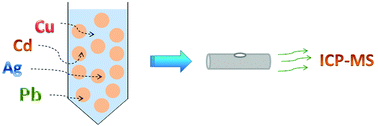Evaluation of electrothermal vaporization as a sample introduction technique for the determination of trace elements in biological samples by inductively coupled plasma mass spectrometry, following dispersive liquid–liquid microextraction
Abstract
This work describes the method development process involved in the determination of Ag, Cd, Cu and Pb in biological samples by electrothermal vaporization inductively coupled plasma mass spectrometry (ETV-ICP-MS), following dispersive liquid–liquid microextraction (DLLME). The parameters associated with DLLME such as HNO3 and diethyldithiophosphate (DDTP) concentrations, as well as the volumes of disperser (ethanol) and extracting (chloroform) solvents, were evaluated. The ICP-MS operating parameters (carrier gas flow rate and RF power) were also optimized. Several distinct approaches involving investigation on chemical modifiers (W, Ru, Pd and combinations), aerosol carriers (Na2SO4, ascorbic acid and diethyldithiophosphate – DDTP) and the effect of insertion of a L'vov platform on the transport efficiency from the ETV to the ICP and overall analytical performance were evaluated. The results suggest that the use of a platform and chemical modifiers lead to increased thermal stability, although the sensitivity is generally reduced when compared to the absence of modifiers and wall vaporization. Several calibration approaches were evaluated, including the combination of chemical modifiers and the use or absence of a L'vov platform inside the graphite tube. Accurate results were achieved for all elements upon the use of palladium as the aerosol carrier in combination with W and Ru as permanent chemical modifiers, demonstrating that the effective transportation of the analytes and equalization of the transport efficiency between samples and calibration solutions are carrier-dependent. To verify the accuracy of the proposed methodology, four certified reference biological materials were analyzed, with good agreement between certified and determined values. ‘Real’ samples were also analyzed following the optimized procedure. The proposed method resulted in detection limits between 0.001 and 0.09 μg g−1 and enhancement factors between 35 and 59, with appreciable analytical sensitivity.

- This article is part of the themed collection: 2014 Young Analytical Scientists

 Please wait while we load your content...
Please wait while we load your content...